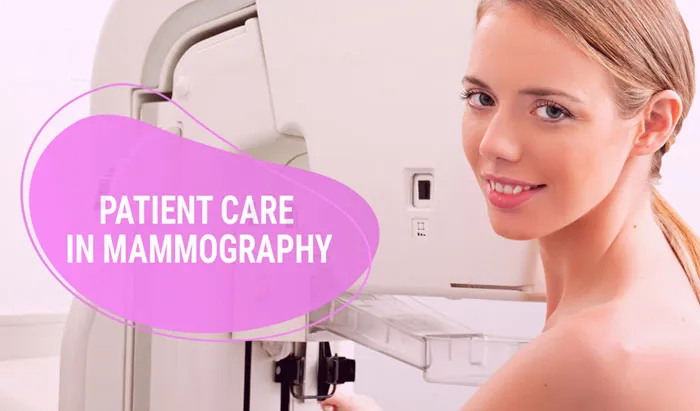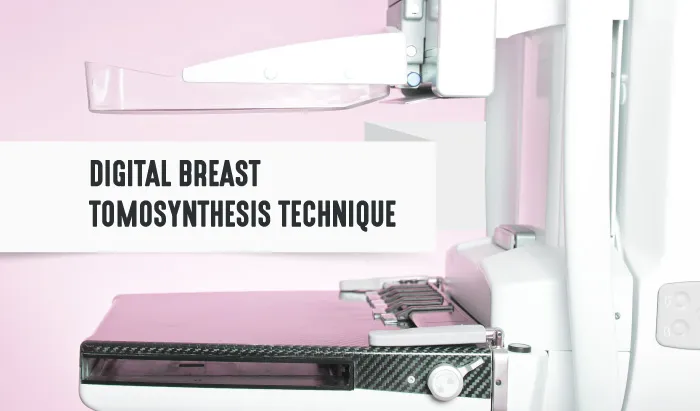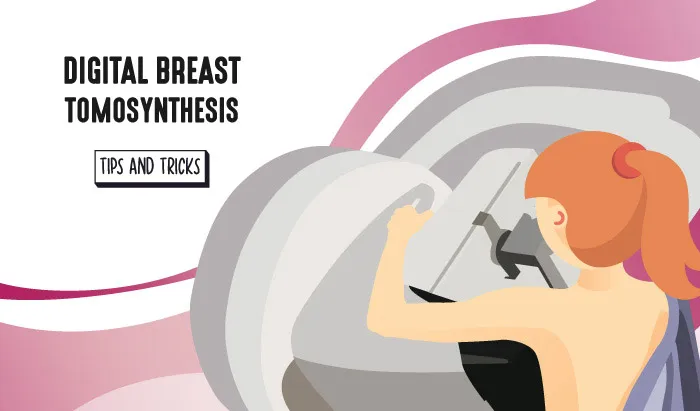Patient Care in Mammography: The Technologist’s Guide

Patient Care in Mammography: The Technologist’s Guide


Patient Care in Mammography: Overview
As mammography technologists, our job is to acquire good quality mammogram images, but this entails so much more than simply positioning a woman’s breasts. We must ensure her comfort and earn her trust and enlist her as a participant in her mammogram, which means being patient, understanding, informed, and compassionate from the moment we greet her to the moment she leaves us.
We have all borne witness to the wide range of emotions a woman coming for a mammogram may feel, from anxiety to helplessness and despair to fear and anger to determination and hope, and everything in between in every imaginable combination. Providing care for the patient, the whole patient—including her emotional and psychological well being and education—is a critical part of being a mammography technologist. And research backs this up: patients are looking for more than just getting a procedure done and over with—they are looking for communication, personal connection, and empathy when their see their healthcare providers.
Below are some suggestions for what you can do to improve mammogram experiences for your patients, and maybe save some more lives.
Patient Care in Mammography: First Impressions Matter
Your first interactions with a patient form the foundations of your relationship with her and shape her future perceptions and experiences with mammograms. In fact, women who have a positive experience with their technologist and their procedure are more likely to cooperate and return for mammograms as per the physician’s recommendations. Conversely, those who have negative experiences are more likely to ignore those recommendations for future exams.
So that first meeting with a patient is very important. It is during this meeting that patients decide whether or not you are friendly and professional, and react—either consciously or otherwise—to that impression of you. Everything from your tone of voice, to how quickly and loudly you speak, to how you move shapes your patient’s impression of you. And that impression can impact their willingness or ability to share medical information or cooperate with you during the procedure. Being aware of your presence—the vibe you give off—is important.
The gist: Your first interactions with a patient are crucial, because they can shape the patient’s future behavior and attitudes toward mammograms, with patients having positive experiences more likely to abide by doctor’s recommendations for future screenings.
Patient Care in Mammography: Impact of Positive Patient Interactions on Patient History

Mammography technologists must be intimately close with their patients to position their bodies, their breasts, their shoulders, their arms to capture quality images of their breast tissue. And patients may run the gamut from a nervous woman going for her first mammogram to the distraught woman who has found a lump in her breast to the woman with breast cancer who is fighting for her life. These women may cry and sniffle, may cough, may groan in discomfort, may be so nervous and insecure about baring one of the most intimate parts of their bodies to a stranger, even a trained medical professional, that they speak in angry fear to their mammographers. Now, these varied but routine interactions so familiar to the mammographers have become charged with the risk of contracting the virus.
- Use your patient’s name when you address them
- Avoid interruptions to the interview. Interruptions can make a patient feel as though they are not your top priority, or that you are not fully devoted to their procedure.
- Be sure to explain to your patient the relevance and importance of taking an accurate family history and patient history and why you need to ask the sorts of questions you will ask.
The gist: Positive interactions increase the likelihood of you obtaining a more complete and accurate patient history. Give the patient your undivided attention and explain the importance and role of medical histories in the breast imaging process.
Patient Care in Mammography: Educating Patients in the Mammography Suite
Your communication with your patient should, of course, be more than just taking their history and giving them instructions during the procedure. It is important for the technologist to educate their patients about mammograms, correct misconceptions, and inform them of the risks and benefits of regular screening. You can encourage your patient to ask questions, which may reveal some misconceptions they have and provide an opportunity for education.
You should also explain the process of the examination, providing a step-by-step breakdown so that your patient knows what to expect and why each part of the procedure is necessary, potentially relieving some of the anxiety your patient may feel and encouraging them to cooperate during the procedure. Here, it is important to use language that your patient understands, rather than complicated medical-speak, as research shows that patients want the professional performing their exam to explain to them and inform them about the process using terminology they can grasp.
The gist: Educating patients about mammograms is part of the technologist’s role. Encourage your patient to ask questions, correct their misconceptions, explain the risks and benefits of screening, and detail the process of the procedure using terms your patient can understand.
Patient Care in Mammography: The Importance of Technologist’s Interpersonal Skills
Compassion and information are typically the top priority for patients during an examination. This makes the technologist’s interpersonal skills critical to the success of examinations that are as personal and intimate as a mammogram. And these skills are entirely unrelated to your technical competency. You can be a wizard at imaging, but if your soft skills are lacking, it may result in negative outcomes for your patients.

Patients coming for a mammogram often feel self-conscious or embarrassed about the exam itself, are expecting the procedure to hurt a great deal, and may be riddled with anxiety about the results, all of which can have an impact on the procedure and subsequent diagnosis. As a technologist, it is your responsibility to develop your interpersonal skills in order to build rapport and trust with the patient and to ensure that she has a positive experience—and will therefore be more likely to return for her annual examination.
The gist: Patients are looking for compassion and information. The technologists’ interpersonal skills can improve patient experiences and thereby ensure a more accurate patient history, the success of the initial exam, and the likelihood that the patient will follow the recommendations for future exams.
Communicating with Patients Verbally and Non-Verbally
- Make sure you look at a patient when you greet them and speak with them before, during, and after the exam, rather than carrying on with other duties while they talk. If you appear busy with other things while your patient is speaking, even if you are listening, your patient may perceive you as uncaring or disinterested, and may not share information or ask questions as freely or readily.
- Use simple language whenever possible. Remember, patients often have little to no background in medical or technical terminology, and may not understand the terminology you use. Simplify it for them.
- Monitor the volume and speed at which you speak, as well as your tone of voice. If you are speaking quickly, patients may think you are in a hurry to get their exam over with, and react negatively. If English is not their primary language, they may have difficulty understanding you, as well.
- Touch is a form of nonverbal communication. You may be using touch during positioning, or as a way to provide psychological or emotional support to a patient, but be aware that some patients, due to cultural differences, may perceive your touch as inappropriate. You should always communicate verbally with all patients when, how, and why you will need to touch them during the mammogram procedure.
The gist: Monitor your verbal communication for tone, speed, and volume and use language your patient can understand. Be aware of your own non-verbal communication and always let a patient know how, when, and why you will need to touch them for the examination.
Active Listening and Careful Observation

You listening skills are also crucial to your communication with your patient, increasing your understanding of what your patient is trying to tell you and the emotions that may be tied to the things they communicate to you.
- Don’t interrupt your patient when she is speaking, and don’t try to steer the flow of the conversation too much beyond the questions you need to ask. You can even provide opportunities for your patient to lead the discussion with their questions.
- Wait. Give time for your patients to think about the questions you have asked them and to respond.
- Remember that your patients may have beliefs or values that are different from yours. You must remain neutral and professional should this be the case. Be aware of your facial expressions and body posture during such interactions.
- Carefully observe your patient’s nonverbal cues, such as their posture and their tone of voice. Do they look away from you when answering questions? Do they shrink their body against itself, suggesting discomfort or apprehension?
- Provide cues that you are interested in your patient’s responses. Phrases like, “Can you tell me more about that?” or “Yes, go on,” can indicate to your patient that you are listening and respect their contributions to the dialogue.
The gist: Active listening can enhance your understanding of your patient’s emotional state. Observe their body language and be patient while they process and respond to questions, and encourage them with positive cues such as “Yes, go on.”
Recognizing Signs of Emotional Discomfort
- take a long time to undress
- turn her back to you
- fold her arms across her chest
- keep an item of clothing around her neck
- avoid making eye contact with you
A woman’s anxiety may affect her compliance, and subsequently the quality of the images, and an unpleasant mammogram experience may result in her not adhering to screening recommendations in the future, screenings which significantly decrease the risk of mortality from breast cancer. For all these reasons, and for the sake of pure and simple compassion and humanity, we must work to reduce patient anxiety and emotional discomfort. Women’s lives may literally depend on it.
The gist: Women who have anxiety about their mammogram my not be cooperative, which can impact the image. Watch for nonverbal cues of anxiety, such as avoiding eye contact or the patient taking a long time to remove her clothing.
Reducing Patient Anxiety and Improving Patient Experiences: A Recap
- Be warm and welcoming
- Smile: Something as simple as a smile can increase our patients’ confidence and trust in us and help us build our relationship with them
- Listen: Listening has a significant effect on patient experience and adherence rates for future screenings. We need to provide time and opportunity for the women in our care to tell us their concerns, fears, and ask us questions. This may also help us learn about a patient’s misconceptions and open the opportunity to correct them.
- Communicate: this is more than casual conversation, though that may help relax patients and make them more comfortable. We need to check in with the woman in front of us, determine how she’s feeling before, during, and after the mammogram.
- Be gentle and sensitive to patient anticipation and experience of pain and discomfort: Be as gentle as possible; instruct and remind the patients in our care to keep their hands between the compression paddle and their breast until the paddle touches the back of her hand. It is recommended to apply the final compression manually and to watch the patient’s face as you apply the compression.
- Be gentle and sensitive to patient anticipation and experience of pain and discomfort: Be as gentle as possible; instruct and remind the patients in our care to keep their hands between the compression paddle and their breast until the paddle touches the back of her hand. It is recommended to apply the final compression manually and to watch the patient’s face as you apply the compression.
- Some newer mammogram technologies have been developed that allow patients some control over compression (under your supervision of course) and have been shown to reduce patient anxiety
- Be transparent and educate patients: patient experience, understanding, and advocacy for screenings is in your hands. You must practice explaining the process and procedure to patients before, during, and after the mammogram. This means:
- providing a step-by-step explanation of the process beforehand and as the mammogram is performed
- breaking down instructions and providing explanations of what we are doing and why
- explaining the need for breast compression
- showing patients how the breast is compressed
- explaining why some women may experience a painful mammogram
- explaining exactly what happens after the exam, including how to get their report and if there will be any follow-up calls
Final Thoughts
Detecting breast cancer at an early stage offers the best hope for patients. Patients coming for a mammogram need to experience care, compassion, reassurance, professionalism, education, and often counseling. As a mammography technologist, you often have to provide all of these in addition to performing the actual mammogram. Your role in delivering patient care is critical to ensuring that women show up for their screenings, to the success of the screening procedure, and, ultimately, to saving women’s lives.
References
- Rickert, J. (2021, January 24). Patient-centered care: what it means and how to get there. Health Affairs. https://www.healthaffairs.org/
- Ndikum-Moffor, F.M., Braiuca, S., Daley, C.M., Gajewski, B.J., Engelman, K.K. (2013). Assessment of mammography experiences and satisfaction among American Indian/Alaska Native women. Womens Health Issues, 23(6), 395-402. doi:10.1016/j.whi.2013.08.003.
- Studer, Q., Robinson, B., & Cook, K. (2010). HCAPHS Handbook. Fire Starter.
- Institute for Healthcare Communication. (2011, July). Impact of communication in healthcare. http://healthcarecomm.org/
- Adler, A., & Carlton, R. (2018). Introduction to radiologic imaging and sciences and patient care (7th ed.). Saunders.
- Palmer, W.J. (2018, February 9). Mammography focuses on patient comfort to improve test rates. Diagnostic Imaging. https://www.diagnosticimaging.com/
- Peipins, L.A., Shapiro, J.A., Bobo, J.K., & Berkowitz, Z. (2006). Impact of women’s experiences during mammography on adherence to rescreening (United States). Cancer Causes Control, 17, 439–447. https://doi.org/
Disclaimer: The information provided on this website is intended to provide useful information to radiologic technologists. This information should not replace information provided by state, federal, or professional regulatory and authoritative bodies in the radiological technology industry. While Medical Professionals strives to always provide up-to-date and accurate information, laws, regulations, statutes, rules, and requirements may vary from one state to another and may change. Use of this information is entirely voluntary, and users should always refer to official regulatory bodies before acting on information. Users assume the entire risk as to the results of using the information provided, and in no event shall Medical Professionals be held liable for any direct, consequential, incidental or indirect damages suffered in the course of using the information provided. Medical Professionals hereby disclaims any responsibility for the consequences of any action(s) taken by any user as a result of using the information provided. Users hereby agree not to take action against, or seek to hold, or hold liable, Medical Professionals for the user’s use of the information provided.



